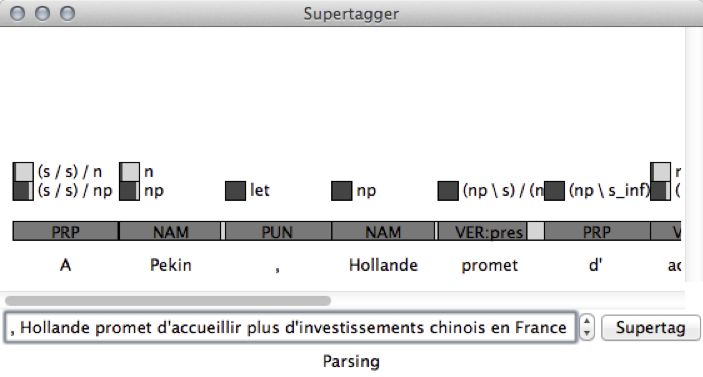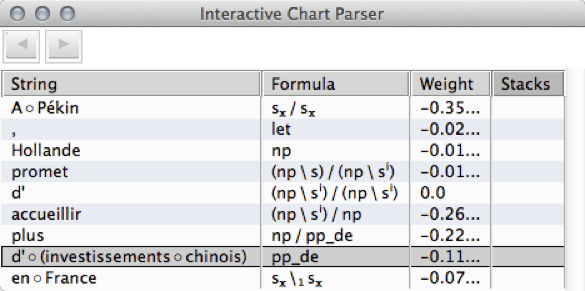GrailLight
Light-weight chart parser for multimodal type-logical grammars
Project maintained by RichardMoot Hosted on GitHub Pages — Theme by mattgraham
GrailLight
:copyright: 2015-2020 CNRS
:copyright: 2015-2020 Richard Moot (@RichardMoot)
Grail Light is a light-weight chart parser for multimodal type-logical grammars, written in SWI Prolog. It is accompanied by a set of auxiliary tools for interaction with the supertagger, interactive parsing, corpus extraction, etc.
Together with DeepGrail or the older part-of-speech tag and supertag models, Grail Light can function as a wide-coverage parser for French, assigning Discourse Representation Structures as the meaning of parsed sentences. Grail Light produces natural deduction proofs like those found in the TLGbank and uses the same conventions for formulas, rules and proofs.
Quick Start
Clone the repository, enter the Grail Light directory, start SWI Prolog then type.
[grail_light_cr,annodis].
This will load Grail Light as well as the sentences from the Annodis corpus.
To parse a sentence, type
sentence(2, Semantics).
This will parse the sentence and unify Semantics with the meaning computed for this sentence.
LaTeX Output
A successful parse will produce a LaTeX representation both of the proof found and of the meaning. To see the LaTeX output, type the following (in a shell terminal).
pdflatex latex_proofs.tex
User interface to the part-of-speech/supertagger
Use the file Supertag.tcl for a TclTk user interface to the part-of-speech tagger and supertagger. You can select either the Keras LSTM taggers and models from DeepGrail (recommended, set the keras_tagger_prefix and keras_model_prefix in Supertag.tcl to the executables and models respectively) or the Clark and Curran taggers with the corresponding French models (set the cnc_tagger_prefix and model_prefix variables in Supertag.tcl to the executables and models respectively).
You can then simply run Supertag.tcl and type an input sentence into the entry field. The result of the supertagger looks as shown in the figure below.

In each case, the darker part of the bar (next to each formula) indicates the probability assigned by the supertagger to the formula (moving the mouse pointer over a formula displays the formula and its probability).
The result of the supertagger is passed as input to GrailLight, and if a proof is found, the syntactic proof can be found be selecting Proof from the File menu, and the meaning (in Discourse Representation Theory) can be found by selecting Semantics from the File menu.
The menu allows you the change the supertagger/models used and the beta value of the supertagger; essentially, larger beta values result in more formulas per word, meaning slower parsing but higher likelyhood of finding a proof. It is recommended to use a fairly high beta value (such as the default 0.1) and only decrease it when no proof is found. Several useful values are available in the Beta item of the Options menu.
User interface to the chart parser
Type make parser.tcl and start the created file parser.tcl to open a rudimentary TclTk interface to the chart parser. Example input files for the parser can be found in the chart_proofs/aux directory of the TLGbank. Giving parser.tcl a file as argument will open a Prolog file containing parser input. You can also load a file by selecting Load from the File menu or try.
head -364 annodis.pl > anno10.pl
./parser.tcl anno10.pl
to manually parse the first 10 sentences of the annodis.pl file in the repository (you can do this for the complete file as well, but this requires a quite a bit of patience reading all data).
After startup, the parser window looks as follows, changing with the input sentence and the parser actions performed.

Each table row displays the current structure, formula, log probability, and stack information of the active items in the chart (read chart_parser.pdf for more information about the chart parser).
You can double-click on table row to apply a chart rule to this item. When there are multiple possibilities, a pop-up allows you to select the desired one (with <Enter>). You can undo a choice by pressing <u>, and export the parser result by pressing x.
User interface for manually annotating and correcting additional sentences
The file treebank_annotator.tcl is another interface to the part-of-speech tagger and supertagger. Contrary to the Supertag.tcl script, this script is useful for manually annotating additional data, bootstrapping with the current output of the taggers, and manually correcting the errors, first of the part-of-speech tags, then of the supertags.
Going Further
The file readme.pdf contains more detailed instructions whereas the
file chart_parser.pdf describes the strategy used by the chart parser.
Acknowledgments
This chart parser has been developed starting from source code originally developed by Shieber e.a. (1995), though with a set of inference rules and a number of improvements which I specifically tailored for multimodal type-logical grammars.
The Prolog file lefff.pl has been automatically extracted from the
Lefff lexicon (Sagot, 2010).
The file annodis.pl has been extracted from the
Sequoia corpus (Candito and Seddah,
2012) and is part of the TLGbank
(Moot, 2015).
References
Marie Candito and Djamé Seddah (2012) Le corpus Sequoia : annotation syntaxique et exploitation pour l’adaptation d’analyseur par pont lexical, Proceedings TALN’2012, Grenoble, France.
Richard Moot (2015) A Type-Logical Treebank for French, Journal of Language Modelling 3(1), pp. 229-265.
Richard Moot (2017) The Grail Theorem Prover: Type Theory for Syntax and Semantics. In Stergios Chatzikyriakidis and Zhaohui Luo (eds.) Modern Perspectives in Type-Theoretical Semantics, pp. 247-277.
Benoît Sagot (2010) The Lefff, a freely available and large-coverage morphological and syntactic lexicon for French. In Proceedings of the 7th international conference on Language Resources and Evaluation (LREC 2010), Istanbul, Turkey
Stuart M. Shieber, Yves Schabes and Fernando C. N. Pereira (1995) Principles and Implementation of Deductive Parsing, Journal of Logic Programming 24(1-2), pp. 3-36.